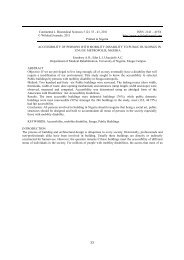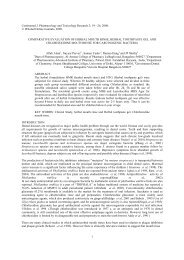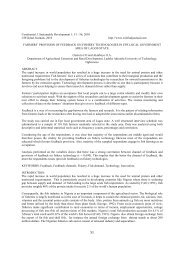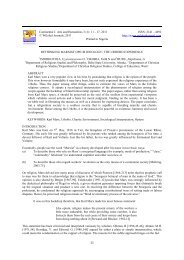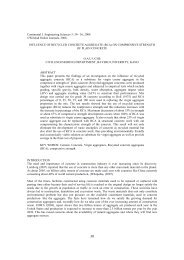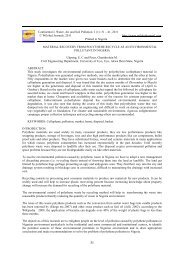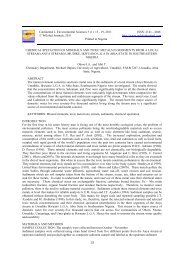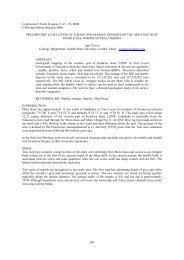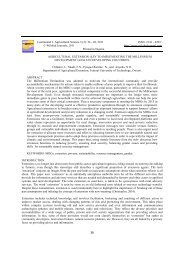Vol 2 - Arts and Humanities - Wilolud Journals
Vol 2 - Arts and Humanities - Wilolud Journals
Vol 2 - Arts and Humanities - Wilolud Journals
You also want an ePaper? Increase the reach of your titles
YUMPU automatically turns print PDFs into web optimized ePapers that Google loves.
Rasak Bamidele: Continental J. <strong>Arts</strong> <strong>and</strong> <strong>Humanities</strong> 2: 7 - 16, 2010The third respondent on her own says that the naming ceremony is performed any time when there is money. Thiscontrasts shows difference with what respondents’ one <strong>and</strong> two have said about the dates the naming ceremony isperformed. The choice of gin over palm wine or any other traditional gin (Ogogoro) must again be the effect ofvalues <strong>and</strong> cultural differences of the family of the third respondent.According to respondent four on the process of naming ceremony: On the morning of the naming ceremony, thepaternal gr<strong>and</strong>mother of the child takes him or her out of the room into the midst of people who are cited for thenaming ceremony, the name to be given to the child is already written on a sheet of paper in a dish that is placed onthe table, where the other materials for the ceremony are. The ‘Elder’, who is leading the ceremony, takes the child,as he says the name he has been given. He simultaneously touches the lips of the child with each of the materialsprovided as he prays for the child.According to the fifth respondent: the Elder sit in the middle of the people who have come for the ceremony. Theelderly man presiding over the ceremony uses chalk to draw a circle on the floor <strong>and</strong> he introduces the child into theworld by putting the child’s legs inside the circle that has been drawn. He then tells the people the name that hasbeen chosen for the child <strong>and</strong> prays for the child with each of the materials provided.According to the sixth respondent: On the morning of the naming ceremony, ‘my child <strong>and</strong> I wear new things’. Theelder who is naming the child prays for him/her with the hot drinks <strong>and</strong> kola nuts.He then pours a bit of the drink on the ground before he gives to everybody present to drink. After praying with thekola nuts, he breaks it into pieces <strong>and</strong> all the people present eat from it.There was no response from respondent seven on the process of naming his children.Respondent eight: The mother of the child is asked to sit on a mat <strong>and</strong> a bow is placed on the mat, the mothercarrying the child open up the mouth of the child <strong>and</strong> the soup prepared is drop into the child’s mouth, this signifiedthat the child is introduced into eating of pepper <strong>and</strong> salt.The ninth respondent simply gave the reason for process in naming a child as Yoruba tradition.According to respondent ten: The head of the family submits selected name(s) to the elders in the hamlet who arepresent at the ceremony.For respondent 11: people are invited, that is, family members <strong>and</strong> close friends, even in-laws. Roasted yam will beprepared <strong>and</strong> red oil with which to eat it with. The hot drink will be ready too. The mother of the child will beinstructed to present the child for naming, once that is done, the eldest man in the family will pronounce the name;<strong>and</strong> entertainment will follow immediately, then the closing prayer.There was no response from respondent 12.The process for respondent 13 is simply praying with the materials by the eldest man for long life for the child.According to respondent 14: the parents send a town crier or any member of the family to inform the elders aboutthe preparation or intension to name their child. You then cook for the visitors, the people contribute money for thechild as well as pray, <strong>and</strong> the parents are allowed to open an account with the money so contributed for the new bornbaby.The other respondents had similar responses from the above, in which they attribute the process of naming a child totraditional belief of the people.14






